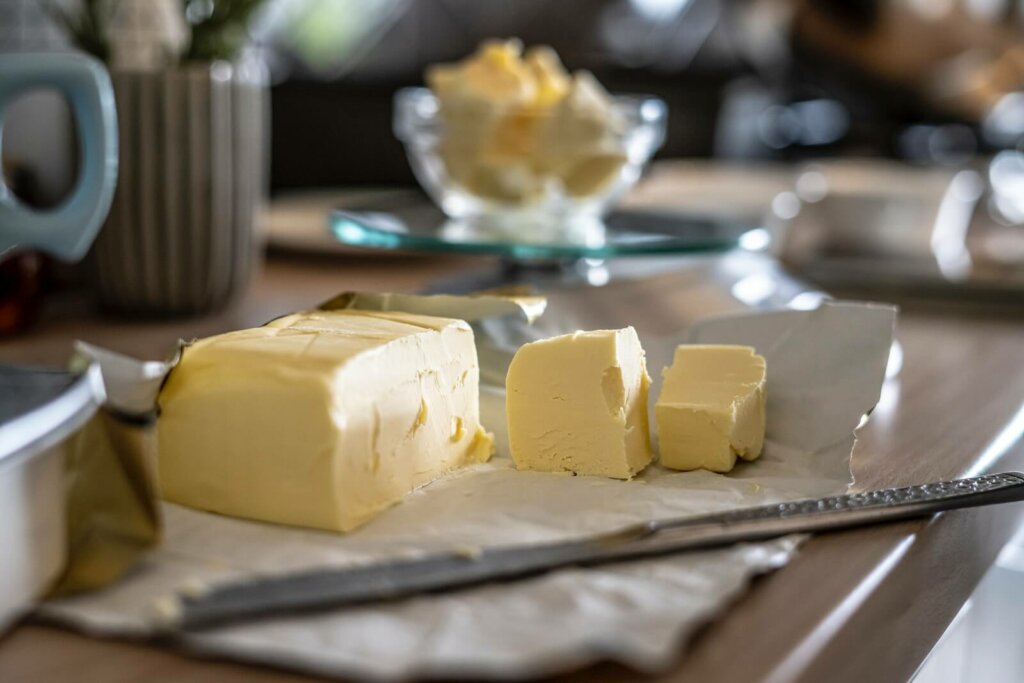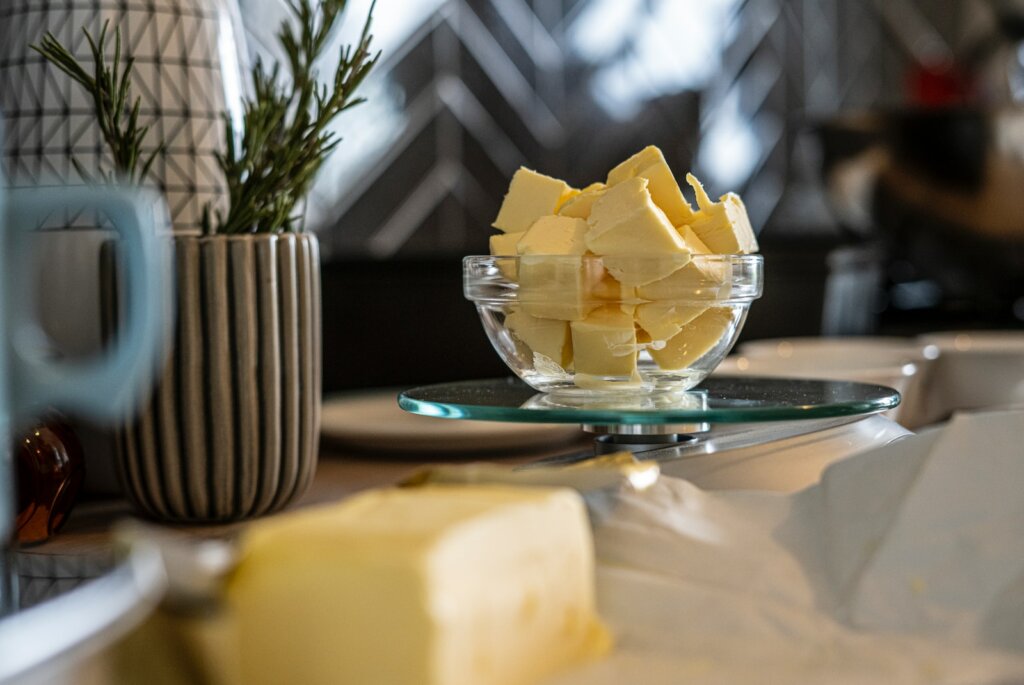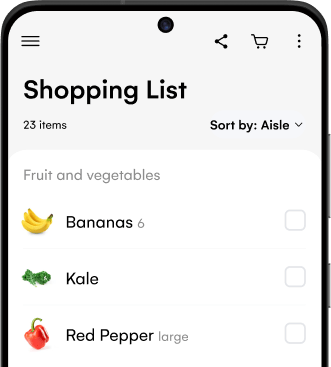The short Answer: One cup of butter contains two sticks of butter.
But unless you have to convert exactly two sticks of butter or one cup of butter, that might not help you. Luckily, a bit of simple math (don’t worry if it’s not your best subject!) can help you figure the rest out.
One cup of butter contains two sticks of butter. That’s 16 tablespoons or 8 ounces. Once you know that one cup of butter = two sticks = 16 tablespoons = 8 ounces, you can build from there.
So, each stick of butter is 1/2 cup, and that’s 57g or 2 oz. With 1 1/2 sticks of butter, you will get 3/4 of a cup.
To make this even easier, scroll down a little further for an easy conversion chart which shows sticks to cups of butter.
Plan meals together! Share this plan with your family

Why is butter sold in sticks?
As a versatile ingredient, butter plays a key role in countless of recipes, from Garlic butter shrimp, to fluffy buttery croissants. It’s hard to image a world without it. And if you’re a baker, you’ll know how much your recipes depend on good quality versions of the yellow stuff.
Depending on where you live, butter is either sold in sticks or blocks. That’s because its square or rectangular shape allows it to be easily shipped and neatly stacked in your local grocery store’s fridge.

But measuring it can sometimes be challenging. Image you’re holding a recipe for a perfect butter cake. The problem? It calls for a certain number of cups of butter, but you’ve only got sticks. Or vice versa. If you haven’t heard of a stick of butter, you’re probably totally lost.
And now you’re thinking: “well, how much is one stick of butter in cups?” In order to make your kitchen experiments easy and enjoyable, we’ve created this easy-to-use butter conversion chart. It will clear any doubt you’ve ever had about measuring for that perfect sauce or pastry.
Butter conversion chart
| Cups | Sticks | Tablespoons | Pounds | Ounces | Grams | Teaspoons |
| 1/4 cup | 1/2 stick | 4 tbsp | 1/8 lb | 2 oz | 57g | 12 tsp |
| 1/2 cup | 1 stick | 8 tbsp | 1/4 lb | 4 oz | 113g | 24 tsp |
| 3/4 cup | 1 1/2 sticks | 12 tbsp | 3/8 lb | 6 oz | 170g | 36 tsp |
| 1 cup | 2 sticks | 16 tbsp | 1/2 lb | 8 oz | 227g | 46 tsp |
| 1 1/4 cup | 2 1/2 sticks | 20 tbsp | 5/8 lb | 10 oz | 284g | 60 tsp |
| 1 1/2 cup | 3 sticks | 24 tbsp | 3/4 lb | 12 oz | 341g | 72 tsp |
| 1 3/4 cup | 3 1/2 sticks | 28 tbsp | 7/8 lb | 14 oz | 398g | 84 tsp |
| 2 cups | 4 sticks | 32 tbsp | 1 lb | 16 oz | 454g | 96 tsp |
How much does one stick of butter weigh?
One stick of butter weighs 113g, or 1/4 lb (4 oz). With two sticks, you get 227g or 1/2 lb (8 oz) of butter.
If you prefer to measure your ingredients by weight, you might want to check out our cups to grams conversion table
The packaging can help
Depending where you live, another thing that might be able to you is the packaging. Sticks of butter are wrapped either in aluminum or wax paper and are often marked with measurements. The standard measurement markings are usually in tablespoons, making it easy to slice off the required amount without needing a scale. So if a recipe calls for 1/2 cup of butter, you will know you actually need 8 tablespoons, or 1/2 stick.

What types of butter are there?
Butter
Butter is a dairy product made by separating whole milk or cream into fat and buttermilk. It’s traditionally made from cow’s milk. However, the milk of other animals such as goats, sheep, and buffalo are used too. Butter usually has around 80% of fat and is used both for baking and cooking. It can be found in stores as salted and unsalted.
Salted Butter
Due to the additional salt, salted butter is a preferred choice for sautéing, frying, and roasting. In baking, it can add a subtle savory taste to sweet treats like cookies and cakes. The added salt also acts as a preservative, extending the butter’s shelf life.
Unsalted butter
Unsalted butter is most commonly used in baking and pastry making. Its neutral flavor allows for better control over the overall taste of dishes. That makes unsalted butter ideal for recipes where the precise amount of salt matters. Using unsalted butter lets you dictate the level of saltiness in your creations, making sure that you have exact control over the balance of flavors. But can you use salted butter in a pinch? Yes, you can, Just be aware that there might be a difference in taste.
Clarified butter
While the butter we all know is made from milk solids, butterfat and water, clarified butter is made by removing milk solids and water. Because of this, clarified butter has a higher smoke point, meaning it can withstand higher temperatures than regular butter. That makes it perfect for frying and sautéing.
Ghee
As one of the key ingredients in Indian and Middle Eastern cuisine, ghee is made by cooking clarified butter longer to remove all moisture. This process gives the remaining milk solids a sweet and caramelized taste. Ghee’s nutty flavor adds an irresistible depth to curries, lentil dishes, and flaky roti.
Save time on grocery shopping

Irish butter
Jumping back to Europe, Irish butter is known for having a higher butterfat content than regular butter. With its vivid yellow hue and a rich, creamy texture, Irish butter is perfect for baking pastries and cakes. It can also be enjoyed on a simple slice of bread.
Dry butter
Also known as Beurre de Tourage, dry butter is made by removing all excess moisture. Because of that, dry butter has a prolonged shelf life and can be stored easily without it going off. It integrates seamlessly into mixes for baked goods such as croissants, and Danishes, sauces and more.
Whipped butter
Whipped butter is basically regular butter that’s been whipped by a mixer or a food processor. The added air gives whipped butter a soft and creamy texture. It goes perfectly with your morning toast, or on top of pancakes and scones. It’s also great when combined with herbs or other flavors and served with bread.
Can I use melted butter instead of softened?
The answer is yes! But there are a few things to consider. Softened butter has a creamy texture and is easier to mix with other ingredients, especially in recipes that require creaming butter and sugar together. On the other hand, melted butter will change the texture of your batter or dough. That might affect the structure and texture of your dish. Additionally, some recipes ask for softened butter to be whipped. The air component changes the texture of butter, which can result in incorrect proportions compared to other ingredients.
What is the difference between butter and margarine?

While butter is always made from milk, margarine is mostly made from vegetable fat. Though rare, milk solids can also be present in margarine, but in very small amounts. Margarine was created in France in the 19th century as a more affordable alternative to butter. It’s also useful in hot places as it can be stored in the fridge while staying easy to spread.
It was designed to mimic butter. Butter offers a rich flavor and the fat in it gives baked goods a fluffy texture. On the other hand, margarine will give your pastries and cookies a flatter shape and less flavor. When choosing between the two, it’s important to consider your dietary preferences, health considerations, and the specific culinary application.
And there you have it! Everything you ever needed to know about measuring butter in sticks, cups, grams, and more – as well as which butter to use for your specific recipe.
